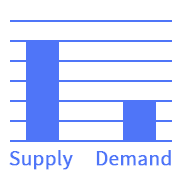Avoiding Inventory Mistakes
Chapter 4 (View all Chapters)
Avoiding Inventory Mistakes
Online businesses come in all shapes and sizes, from massive marketplaces with multiple fulfillment centers located throughout the country, to home office start-ups whose garage doubles as their inventory warehouse. Big or small, maintaining accurate stock records is essential to the success of your business. To minimize risk, you should be familiar with some of the most common mistakes that online businesses make when it comes to managing stock.
Overselling
|
|
One of the most common issues that online merchants face is selling more product than they actually have on hand. Having inaccurate stock levels can lead to products being presented as available when they’ve actually sold out. Undoubtedly, this tends to lead to a poor experience for the customer, who then gets notified of the error after they’ve been charged. At this point, they are likely to cancel the order and start shopping elsewhere. Even worse, they may leave you with a bad review, or call you or your store out in social media. It’s a good idea to keep safety stock of your most popular or staple products on hand to account for unexpected supplier delays or higher than expected sales volume. |
Over Ordering
|
|
At the other end of the inventory spectrum from overselling, over ordering is basically the opposite. Instead of not having enough inventory to satisfy orders, merchants run the risk of ordering too much product. There are a number of pitfalls that come about with over ordering, such as:
|
Poor Supply Expectations
|
|
It’s important to be aware of industry news and trends to keep your business ahead of the curve when it comes to managing inventory. For your unique business, you probably have some idea of which products are in demand at which times of the year. If your products are dependent upon other factors — like availability of raw materials or transportation issues — it’s best to keep an ear to the ground for industry news that could affect your supply of product. |
Outdated Pricing
|
|
Pricing can be a complex issue for many businesses. You should review your pricing practices on a regular basis to ensure your prices are competitive in your market. Having out of date prices on your products can cause them to sit on the shelf for weeks or months at a time, causing wasted shelf space and draining your operating capital. |
Warehouse System Weakness
|
|
It’s not uncommon for warehouse managers to fail in finding more efficient ways to handle business. Simply rearranging goods so they’re easily taken out for shipment can save you thousands of dollars. Often times, employees take too much time going through the facility looking for an item. Always remember that wasted time is money lost. A simple solution is to figure out which items sell more and place them near the shipping area so they can easily get sent out. Sales reports should give you a good idea which items to put close to the door. Additionally, take into careful consideration about where certain products are stored. Allot a specific area for each product based on popularity so they can be easily retrieved. |
Infrequent Inventory Checks
|
|
Many companies cease operations for a day to check inventory. This can result in profit loss. It’s worse for huge businesses with giant catalogs - they can end up profitless for weeks. This is an outdated method and one that’s not productive at all. You’re better off scheduling more frequent regular inventory checks to keep the company from shutting down operations and missing out on sales. Using an online inventory management system will eliminate the need for this. A reliable system, like the ones found in our App Marketplace, will keep you updated on the status of your inventory in real time. Inventory management can be tedious, but using a streamlined process — preferably one with a reliable tool — will greatly reduce mistakes and improve operations which can lead to more sales. |
Human Error
|
|
One of the most common mistakes merchants make is they rely on anecdotal evidence in buying decisions. They may use personal experience to recall something as being popular, but don't check actual sales data / return data to get a more holistic, accurate picture. Mistakes are inevitable, but you can minimize their frequency and effect with a consistent training program for your employees. Having workers that interact with inventory go through a refresher course every few months can help identify friction within current processes, and presents an opportunity to brainstorm for improvements and discuss best practices. Many companies also make the mistake of using a localized software that most employees are not trained in, which can create bottlenecks in inventory and order fulfillment. Lack of proper training can severely affect your ability to keep up with orders. Consider instituting a regularly scheduled training program, or making the switch to SAAS inventory solution. |
BigCommerce Premium Partner Coalition Technologies and their director of digital strategy, Jordan Brannon, took the time to share their expertise and professional tips throughout this guide. Coalition and Jordan are a long standing BigCommerce partner and have helped hundreds of our clients with design, development, and search engine marketing initiatives. We thank them and encourage you to visit https://coalitiontechnologies.com/big-commerce.
If this guide doesn’t contain the information you were looking for, feel free to connect with expert clients, and BigCommerce Partners and BigCommerce staff in our Community. You can ask your specific question or start a dialog to gain advice regarding your business.







 © Copyright 2003 - 2024 BigCommerce Pty. Ltd. Shopping Cart Software
© Copyright 2003 - 2024 BigCommerce Pty. Ltd. Shopping Cart Software